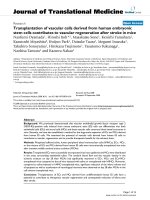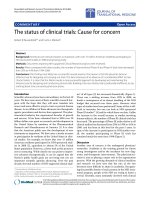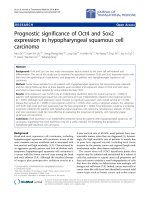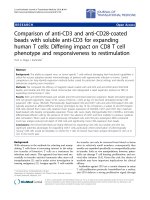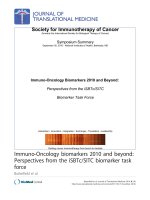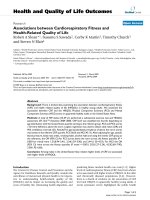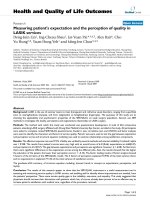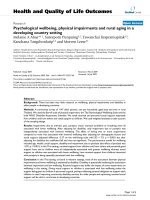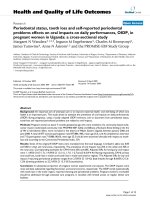báo cáo hóa học: " Periodontal status, tooth loss and self-reported periodontal problems effects on oral impacts on daily performances, OIDP, in pregnant women in Uganda: a cross-sectional study" potx
Bạn đang xem bản rút gọn của tài liệu. Xem và tải ngay bản đầy đủ của tài liệu tại đây (658.08 KB, 10 trang )
BioMed Central
Page 1 of 10
(page number not for citation purposes)
Health and Quality of Life Outcomes
Open Access
Research
Periodontal status, tooth loss and self-reported periodontal
problems effects on oral impacts on daily performances, OIDP, in
pregnant women in Uganda: a cross-sectional study
Margaret N Wandera*
1,2,3
, Ingunn M Engebretsen
3
, Charles M Rwenyonyi
2
,
James Tumwine
4
, Anne N Åstrøm
1,3
and the PROMISE-EBF Study Group
Address:
1
Institute of Clinical Odontology, Faculty of Medicine and Dentistry, University of Bergen, Norway,
2
Department of Dentistry, Makerere
University, Uganda,
3
Center for International Health, University of Bergen, Norway and
4
Department of Paediatrics & Child Health, School of
Medicine, Makerere University, Kampala, Uganda
Email: Margaret N Wandera* - ; Ingunn M Engebretsen - ;
Charles M Rwenyonyi - ; James Tumwine - ; Anne N Åstrøm - ; the
PROMISE-EBF Study Group -
* Corresponding author
Abstract
Background: An important aim of antenatal care is to improve maternal health- and well being of which oral
health is an important part. This study aimed to estimate the prevalence of oral impacts on daily performances
(OIDP) during pregnancy, using a locally adapted OIDP inventory, and to document how periodontal status,
tooth-loss and reported periodontal problems are related to oral impacts.
Methods: Pregnant women at about 7 months gestational age who were members of a community based multi-
center cluster randomized community trial: PROMISE EBF: Safety and Efficacy of Exclusive Breast feeding in the Era
of HIV in Sub-Saharan Africa, were recruited in the district of Mbale, Eastern Uganda between January 2006 and
June 2008. A total of 877 women (participation rate 877/886, 98%, mean age 25.6, sd 6.4) completed an interview
and 713 (participation rate 713/886, 80.6%, mean age 25.5 sd 6.6) were examined clinically with respect to tooth-
loss and according to the Community Periodontal Index, CPI.
Results: Seven of the original 8 OIDP items were translated into the local language. Cronbach's alpha was 0.85
and 0.80 in urban and rural areas, respectively. The prevalence of oral impacts was 25% in the urban and 30% in
the rural area. Corresponding estimates for CPI>0 were 63% and 68%. Adjusted ORs for having any oral impact
were 1.1 (95% CI 0.7-1.7), 1.9 (95% CI 1.2-3.1), 1.7 (1.1-2.7) and 2.0 (0.9-4.4) if having respectively, CPI>0, at least
one tooth lost, tooth loss in molars and tooth loss in molar-and anterior regions. The Adjusted ORs for any oral
impact if reporting periodontal problems ranged from 2.7(95% CI 1.8-4.2) (bad breath) through 8.6(95% CI 5.6-
12.9) (chewing problem) to 22.3 (95% CI 13.3-35.9) (toothache).
Conclusion: A substantial proportion of pregnant women experienced oral impacts. The OIDP impacts were
most and least substantial regarding functional- and social concerns, respectively. The OIDP varied systematically
with tooth loss in the molar region, reported chewing-and periodontal problems. Pregnant women's oral health
should be addressed through antenatal care programs in societies with limited access to regular dental care
facilities.
Published: 14 October 2009
Health and Quality of Life Outcomes 2009, 7:89 doi:10.1186/1477-7525-7-89
Received: 23 April 2009
Accepted: 14 October 2009
This article is available from: />© 2009 Wandera et al; licensee BioMed Central Ltd.
This is an Open Access article distributed under the terms of the Creative Commons Attribution License ( />),
which permits unrestricted use, distribution, and reproduction in any medium, provided the original work is properly cited.
Health and Quality of Life Outcomes 2009, 7:89 />Page 2 of 10
(page number not for citation purposes)
Background
During pregnancy, hormones alter immuno-responsive-
ness and inflammatory response mediators. This has been
reported to cause oral problems, primarily gingivitis and
periodontal infection [1,2]. Pregnancy gingivitis ranges
from asymptomatic erythema to severe cases with pain
and bleeding of the gingival tissue, affecting 30%-100% of
pregnant women in industrialized countries [3-5]. The
severity of gingival inflammation has proved to be higher
during pregnancy than after delivery, although no signifi-
cant changes occur in the amount of plaque [6]. Moreo-
ver, gingival bleeding during pregnancy has been found to
be less influenced by the method of oral hygiene applied
and to be worse during the second- compared to the third
trimester of pregnancy [7]. Whereas some studies have
reported no association between parity (i.e. number of
children borne) and tooth-loss, others have confirmed
that increased parity is related to having fewer numbers of
teeth [1,8].
Periodontal diseases produce a wide range of clinical signs
and symptoms, such as tooth loss, altered appearance,
pain, bleeding, bad breath and impaired quality of life
[9,10]. Loss of posterior occluding support has been asso-
ciated with impaired chewing efficiency and inadequate
nutrition [11]. Inefficient chewing might increase the like-
lihood of over-preparing food in an effort to make con-
sumption possible, whilst in this process, loosing
important nutrients [12]. Inadequate nutrition during
pregnancy may lead to poor fetal growth which might
implicate health problems occurring in later life. For
example, poor nutrition during pregnancy may lead to
interference with kidney development in fetus, which in
turn will lead to raised blood pressure in adulthood [13].
Recently, Taylor and Borgnakke [14] concluded that self-
reported periodontal disease might be valid for surveil-
lance of periodontal disease burden and trends in popula-
tions in lieu of more costly clinical examinations. Studies
continue to document oral symptoms indicative of poor
periodontal health occurring in at least one third of preg-
nant women in several countries [2,5,15]. Furthermore,
pregnancy has been characterized by low use of dental
services in spite of frequently reported periodontal symp-
toms [16].
A better understanding of the social, psychological and
functional consequences of periodontal disease and tooth
loss during pregnancy would assist the planning and eval-
uation of dental care for pregnant women and thus
address their needs and concerns. So far, few studies have
focused on how periodontal diseases affect the quality of
life of the general population. Studies of the psycho-social
consequences of the oral condition in pregnant women
are almost non-existent and yet in two recent studies, con-
sidering referred periodontal patients in Great Britain and
young adults in Hong Kong, the hypothesis that perio-
dontal health impacts on people's quality of life was con-
firmed [17,18].
Since the seminal work of Cohen and Jago [19], research-
ers have increasingly been concerned with the functional
and social consequences of oral problems and a number
of instruments have been developed to measure oral
health related quality of life (OHRQoL). The oral impact
on daily performances (OIDP) is one of such instruments
[20], developed to measure oral impacts that seriously
affect a person's daily life activities. It consists of 8 items
that assess the impact of oral conditions on basic activities
and behaviours that cover the physical, psychological, and
social dimensions of daily living. When applied in the
context of low-income countries, the OIDP has shown to
be psychometrically acceptable among the adolescent-,
young adult- and elderly populations in Tanzania and
Uganda [21,22]. There are no previous studies on the oral
health of pregnant women in Uganda and only one study
has so far applied OIDP in the context of pregnant women
from a low income country, Brazil [23].
Focusing on pregnant women at about 7 months gesta-
tional age, resident in Mbale district, Eastern Uganda, this
study aimed to estimate the prevalence of OIDP, and
examine the relationship of oral impacts with periodontal
status, tooth loss and self-reported symptoms suggestive
of periodontal disease. Furthermore, this study examined
whether tooth loss influenced self reported problems of
chewing common Ugandan foods, and assessed the rela-
tionship of self reported chewing problems with OIDP.
Methods
Study area
Participating women of the present study were members
of a multicentre randomized community trial and birth
cohort study ("Safety and efficacy of exclusive breast feed-
ing (EBF) promotion in an African setting with high prev-
alence of HIV"- PROMISE EBF) conducted in Uganda and
three other sub Saharan African countries - Burkina Faso,
Zambia and South Africa. A district was selected as the
intervention site with the randomization unit being 1-2
villages of on average 1000 inhabitants (35 infants per
year given a birth rate of 3.5%).
Study population
Pregnant women resident in twenty four villages selected
for randomization in urban and rural areas of Mbale dis-
trict, Eastern Uganda, were recruited consecutively by
local community leaders into the Promise EBF study
between January 2006 and June 2008. Urban villages were
sited within Mbale municipality while rural villages were
sited in Bunghoko sub-county. A total of 886 pregnant
women were eligible to participate in interviews and oral
Health and Quality of Life Outcomes 2009, 7:89 />Page 3 of 10
(page number not for citation purposes)
clinical examination. This number satisfied a sample size
of 800 pregnant women calculated for the oral sub-study,
assuming a prevalence of tooth loss (i.e. at least one tooth
lost) of 50%, a precision of 0.05 and a design effect of 2.
As this study included several outcomes, the size of the
sample was calculated separately for each of them and the
largest sample size required was adopted. The procedures
of recruitment and participation in the Promise EBF study
are detailed in another publication [24]. Ethical Clearance
was obtained from the Ethical board, Faculty of Medicine,
Makerere University. Written consent was obtained from
all participants in the study and verbal consent was
obtained prior to each examination and interview.
Measures
Structured interviews were designed with EpiHandy soft-
ware to be used on handheld computers [25]. Interviews
were conducted in face to face settings with participants at
household level. The interview schedules were developed
in English and translated into the local language of Luma-
saaba. Oral health professionals reviewed the interview
schedule for semantic, experiential and conceptual equiv-
alence and sensitivity to culture and selection of appropri-
ate words were considered. The interview schedules were
piloted before administration. The conceptual model
adapted from the model of Wilson and Cleary [26] link-
ing indicators of oral diseases to their symptomatic-, func-
tional- and disability consequences was applied to
identify factors to consider as determinants of OHRQoL
and to structure the multivariate analyses. The interviews
covered questions on mother's health status, socio-demo-
graphic characteristics and perceived oral health status.
Self-reported periodontal problems were assessed by asking
respondents about their experience with bleeding gums,
color change in gums, swollen gums, tooth decay, bad
breath, bad taste toothache and pain in gums. Responses
were categorized as no = 0 and yes = 1. Self-reported chew-
ing problems were assessed by asking women whether or
not they anticipated difficulties eating seven Ugandan
food items (green banana, millet bread/maize meal, rice,
cassava, meat, vegetables and fish) (responses were 0 = no,
1 = yes) The food items were identified through discus-
sions with residents of the area prior to designing the
interview. The seven food items were added into a chew-
ing problem index (range 0-7) and dichotomized into 0 =
no difficulties with chewing food items and 1 = difficulty
with chewing at least one food item. Oral disadvantage or
the psychosocial consequences of oral disease and tissue
damage were measured broadly using seven of the origi-
nal eight item OIDP inventory (i.e. During the previous 6
months - how often have problems with your teeth and
mouth caused you any difficulty with; eating, speaking,
cleaning teeth, smiling, sleeping, work performance and
social contact). The OIDP item considering emotional sta-
bility was removed due to problems with translation into
the local language and possible misinterpretation by the
study group. Each frequency item was scored 0-3, where
(0) never, (1) less than once a month, (2) once or twice a
month up to once or twice a week, (3) 3-4 times a week or
more often. Finally, the extent of oral impacts, OIDP-
extent, (range 0-7) was calculated as a simple count score
(OIDP SC); i.e. summing dichotomized frequency items
in terms of (1) affected (including the original categories
1,2,3) and (0) not affected (including the original cate-
gory 0). Socio-demographics were assessed in terms of place
of residence, age, educational level, last dental visit, parity
and months of pregnancy. Family wealth was assessed as
an indicator of socio-economic status in accordance with
a standard approach in equity analyses [27]. Household
durable assets indicative of family wealth (e.g. bicycle, tel-
evision, car, motor cycle) assessed as (1) available/in
working condition, (2) not available/nor in working con-
dition were analyzed with principle component analysis,
PCA. The first component resulting from the analysis was
used to divide households into four approximate quartiles
of wealth status ranging from 1
st
quartile (least poor) to
4
th
quartile (most poor). The socio-demographic variables
controlled for in the analyses, their coding and the
number of subjects (%) according to categories in urban
and rural residence are shown in Table 1.
Clinical oral examination
A trained and calibrated dentist (MW) carried out all clin-
ical oral examinations under field conditions based on the
World Health Organization (WHO) criteria [28], record-
ing the data on a prepared record sheet. All fully erupted
permanent teeth were scored, excluding third molars.
Oral examinations were performed at house hold level
with subjects seated, examiner using a headlamp as source
of illumination, mouth mirror and a periodontal probe.
Neither radiographic examination nor drying of teeth was
performed. Periodontal status was assessed using a specially
designed lightweight CPITN probe with a 0,5 mm ball tip
with periodontal pockets were measured from the edge of
the free gingiva to the bottom of the pocket. Using the epi-
demiological part of the CPITN, the Community Perio-
dontal Index (CPI) [28,29] with 10 index teeth
(17,16,11,26,27,47,46,31,36,37) and 6 sextants (17-14,
13-23, 24-27, 38-34, 33-43, 44-47) per individual, four
indicators of periodontal status were applied. Only index
teeth were examined and the criteria used were; healthy
periodontal status (code 0), bleeding on probing
observed (code 1), calculus detected during probing (code
2), pocket 4-5 mm (code 3) and pocket >5 mm (code 4).
Each index tooth was scored on 2 sites (buccal and lin-
gual) and each sextant was scored according to its highest
CPI score. If no index tooth was present in a sextant, all
the remaining teeth in that sextant were examined and the
highest score is recorded as the score for that sextant. In
accordance with the hierarchical assumption of the CPI
Health and Quality of Life Outcomes 2009, 7:89 />Page 4 of 10
(page number not for citation purposes)
index, teeth with score 3 were assumed positive with
respect to bleeding and calculus whereas teeth with score
2 were assumed positive with respect to bleeding [30].
Prevalence of bleeding-, calculus and pocket sextants was
assessed as the percentage of subjects affected, or percent-
age of subjects having at least one affected sextant. Preva-
lence of healthy sextants was assessed as the number of
subjects having 6 healthy sextants. Severity of periodontal
condition was assessed by the mean number of sextants
having CPI code 0,1,2,3 and 4. Total CPI was also pre-
sented as the percentage distribution of dentate subjects
according to highest score in the mouth. For analyses this
total CPI score was dichotomized into CPI = 0 and CPI>0.
Tooth-loss was recorded for all teeth except the third molars
and in terms of loss of any tooth (1 = yes, 0 = no), at least
1 tooth lost in both anterior & premolar regions (1 = yes,
0 = no), at least one tooth lost in molar region only (1 =
yes, 0 = no) and at least 1 tooth lost in both in anterior &
molar regions (1 = yes, 0 = no).
Reproducibility
Duplicate clinical examinations were carried out on 50
mothers considered to be representative of the study par-
ticipants after a period of one month. Analysis performed
on the duplicate examination recordings gave Kappa val-
ues of 0.91 for missing teeth. With respect to indicators of
periodontal condition, kappa values ranged from 0.48
(CPI index tooth 11) to 0.85 (CPI index tooth 31). These
figures indicate moderate to good intra examiner reliabil-
ity according to WHO [28].
Statistical analysis
Data was analyzed using SPSS version 15.0 (Chicago, IL,
USA). Cross tabulation, chi square statistics and Univari-
ate ANOVA were used to assess bivariate relationships.
Logistic regression analyses were conducted with OIDP
and chewing problems using the logit model and 95%
Confidence intervals (CI) given for the odds ratios.
Results
Description of the study population
A total of 877 women (mean age 25.6, sd 6.4) completed
interviews at about 7 months gestational age. Of the 877
participants, 713 (mean age 25 yr) underwent clinical oral
examination. The total participation rate was 80%. Rea-
sons for not participating in the clinical examination were
difficulties to locate women, withdrawal of consent and
death. A total of 26.7% versus 73.3% (n = 877) of the par-
ticipants were resident in urban and rural areas of Mbale
district. The majority (84.6%) were in or beyond their 7
month of gestation. Only 2.7% of the women confirmed
to use of any kind of tobacco product. The frequency dis-
tribution of socio-demographic characteristics varied sys-
tematically with place of residence (Table 1). Urban
women were younger, had higher level of education, were
less poor according to the wealth index, more often
unmarried and more often dental visitors compared to
their rural counterparts. Mean number of missing teeth
was 0.79 (sd = 1.2) in urban and 0.75 (sd = 1.3) in rural
areas. The corresponding prevalence of tooth loss was
42.5% and 33.8%. A total of 37.0%, 4.4%, 58.6% and
1.7% urban residents had total CPI scores of 0, 1, 2 and 3.
Table 1: Socio-demographic indicators among pregnant women in urban and rural areas of Mbale district. (n = 877)
Urban Rural p-value
% (n = 234)* % (n = 633)*
Age: ≤ 20 yr 28.4 (63) 25.6 (158)
21-30 yr 59.0 (131) 51.9 (320)
31-45 yr 12.6 (28) 22.5 (139) 0.006
Education: Low (< 4 yr) 14.5 (31) 21.6 (122)
(number of years in school) Medium (5- 8 yr) 55.6 (119) 65.2 (369)
High (>9 yr) 29.9 (64) 13.3 (75) 0.000
Household assets: 1
st
quartile-most poor 12.0 (26) 21.4 (130)
2
nd
quartile 22.7 (49) 40.7 (247)
3
rd
quartile 18.1 (39) 20.4 (124)
4
th
quartile - least poor 47.2 (102) 17.5 (106) 0.000
Marital status: Not married 48.7 (109) 34.7 (217)
Married 51.3 (115) 65.3 (409) 0.000
Last dental visit: less than 6 months ago 8.3 (17) 4.7 (28)
more than 6 months 28.9 (59) 22.5 (134)
never 62.7 (128) 72.8 (433) 0.016
Months of pregnancy: seven or more 87.5 (196) 83.4 (497)
less than seven 12.5 (28) 16.6 (99) 0.160
Parity: one or more 74.6 (167) 78.3 (490)
none 25.4 (57) 21.7 (136) 0.265
*The total number of the various categories do not add to 877 due to missing values
Health and Quality of Life Outcomes 2009, 7:89 />Page 5 of 10
(page number not for citation purposes)
Corresponding figures among rural residents were 31.7%,
2.8%, 65.3% and 0.2%.
Non response analyses
One hundred and sixty four out of the 877 interviewed
women did not participate in the clinical examination. In
order to analyze the possibility that selection bias
occurred from this sample attrition, a comparison was
made of the socio-demographic characteristics of partici-
pants and non-participants. This non-response analysis
revealed less substantial differences between the two
groups with the frequency distributions of age, education,
household assets and parity being similar. However, 78%
versus 68% (p < 0.05) of respectively non-respondents
and respondents reported having never visited a dentist.
Psychometric properties, prevalence and socio-
demographic distribution of OIDP
Cronbach's alpha for the 7 OIDP items was 0.81 (0.85 in
urban and 0.80 in rural area). A total of 15.8% (84) and
70.3% (166) of participants without and with any oral
impact (OIDP > 0) were dissatisfied with their oral health
condition. In both urban and rural areas impacts on eat-
ing were most prevalent (24.5% in urban and 24.4% in
rural), followed by cleaning (19.3% in urban and 21.3%
in rural) and sleeping (19.1% in urban and 17.2% in
rural). Fifty-nine (25.5%) and 175 (30.6%) of respec-
tively, urban and rural participants confirmed experience
with at least one oral impact on daily performance (Table
2). Among women with impacts, 27.1% had one, 22.5%
two and 8.9% had seven oral impacts. The prevalence of
OIDP in the total sample was 30.7% and the age distribu-
tion was 25.0%, 32.3% and 32.9% (ns), in respectively ≤
20 yr-, 21-30 yr- and 31-45 yr olds. Oral impacts was more
frequently reported among women with several previous
births (multiparous) compared to their counterparts that
had not yet given birth (primiparous) (p < 0.05) and
among recent dental attendees, compared to non-attend-
ees (p < 0.001).
OIDP, periodontal condition and tooth loss
Since OIDP did not vary systematically with place of resi-
dence (urban/rural), it's distribution according to clinical-
and self-reported oral problems was reported for the sam-
ple as a whole. As shown in Table 3, impacts on eating dis-
criminated between those with CPI score 0 and those with
CPI score >0 (20.1% versus 27.7%, p < 0.05). Each OIDP
frequency item varied systematically with tooth loss in the
molar region only and with tooth loss in the molar &
anterior regions. Binary logistic regression analyses adjust-
ing for potential confounding variables revealed adjusted
odds ratios, OR, for experiencing any oral impact (OIDP
> 0) of 1.9, 1.7 and 2.0 if having respectively, any tooth
loss, tooth loss in molar region only and tooth loss in the
anterior and molar regions (Table 4). A statistically signif-
icant two-way interaction occurred between tooth loss in
the molar region and age group. Stratified analyses
revealed that the OR for having OIDP > 0 if having tooth
loss in the molar region declined with increasing age and
were 9.7 (95% CI 3.8-24.5), 2.6, (95% CI 1.6-4.2) and 0.8
(95% CI 0.4-1.9), for the age groups <20 yr, 21-30 yr and
31-45 yr, respectively.
Association of OIDP with reported symptoms suggestive of
periodontal disease
The most commonly reported periodontal symptom was
bleeding gums (49.8%), followed in descending order by
toothache (31.8%) and pain in gums (24.2%). All
reported symptoms discriminated statistically signifi-
cantly between women with and without oral impacts.
After adjusting for potential confounding variables in
binary logistic regression analyses, the ORs for reporting
any impact ranged from 2.7 (95% CI 1.8-4.2) with respect
to bad breath to 22.3 (95% CI 13.3-35.9) regarding tooth-
ache (Table 5). A statistically significant two-way interac-
tion occurred for the terms (bleeding gums × age).
Stratified analyses revealed that the ORs of having any
impact if reporting bleeding gums were 7.2 (95% CI 3.4-
15.1), 5.1 (95% CI 3.1-8.2) and 2.0 (95% CI 0.99-4.0) for
the age groups <20 yr, 21-30 yr and 31-45 yr, respectively.
Table 2: Prevalence of oral impacts and the mean oral impacts on daily performance score in pregnant women according to urban and
rural place of residence (n = 877).
Experience of OIDP in last 6 months OIDP score
Urban area Rural area Urban area Rural area
% (n) % (n) Mean (sd) Mean (sd)
Eating 24.5 (50) 24.4 (145) 0.4 (0.7) 0.4 (0.7)
Speaking 8.8 (18) 9.1 (54) 0.11 (0.4) 0.1 (0.4)
Cleaning 19.8 (40) 21.3 (126) 0.3 (0.8) 0.4 (0.8)
Sleeping 19.1 (38) 17.2 (101) 0.2 (0.4) 0.2 (0.5)
Smiling 6.4 (13) 5.1 (30) 0.07 (0.3) 0.06 (0.2)
Carry out work 12.7 (26) 11.9 (70) 0.2 (0.4) 0.1 (0.4)
Enjoy social contact 6.8 (14) 6.2 (37) 0.07 (0.2) 0.06 (0.3)
Overall 25.5 (59) 30.6 (175) 1.3 (2.6) 1.4 (2.6)
Health and Quality of Life Outcomes 2009, 7:89 />Page 6 of 10
(page number not for citation purposes)
Association of OIDP and tooth loss with reported chewing
problems
The prevalence of problems with chewing common Ugan-
dan foods ranged from 28.9% concerning meat to 3.5%
concerning matooke (green banana). A total of 31.4%
had problems chewing at least one common food item. As
shown in Table 6, the adjusted OR for reporting problem
chewing at least one common food item was 1.8 (95% CI
1.2-3.0) if having lost at least one tooth whereas adjusted
OR for reporting any oral impact (OIDP > 0) if having
problem chewing at least one common food was 8.6
(95% CI 5.6-12.9).
Discussion
An important aim of antenatal care is to improve maternal
health and well-being of which dental health constitutes
an integral part [15]. The present study applied for the first
time a translated into Lumasaaba version of the OIDP fre-
quency inventory to a sample of pregnant women resident
in urban and rural areas of Mbale region, Eastern Uganda.
Although the OIDP inventory has previously shown to be
applicable to adolescents and young adults in Uganda
[22], the present study setting necessitated a reestablish-
ment of its psychometric properties including evaluation
of the validity of the inventory. When used in personal
Table 3: Frequency distribution of oral impacts in pregnant Ugandan women according to Community Periodontal index and missing
teeth (n = 713)
CPI = 0 CPI ≥ 1 No loss of tooth in
anterior & molar
region
Loss of at least 1 tooth
in both anterior &
Molar region
No loss of molar
teeth
Loss of at least 1
molar tooth
Impact % (n) % (n) % (n) % (n) % (n) % (n)
Eating 20.1 (44) 27.7 (125)* 23.6 (150) 55.9 (19)** 20.2 (99) 38.7 (70)**
Speaking 7.8 (17) 9.3 (42) 8.2 (52) 21.2 (7)** 4.9 (24) 19.3 (35)**
Cleaning 17.4 (38) 22.8 (102) 20.2 (128) 36.4 (12)* 18.3 (89) 28.5 (51)*
Sleeping 15.6 (34) 18.8 (83) 16.1 (101) 48.5 (16)** 13.5 (65) 29.2 (52)**
Smiling 5.0 (11) 5.6 (25) 4.6 (29) 20.6 (7)** 3.5 (17) 10.6 (19)*
Carry out
work
12.3 (27) 12.7 (57) 11.6 (74) 31.3 (10)* 8.2 (40) 24.4 (44)**
Enjoy
social
contact
5.9 (13) 7.1 (32) 6.1 (39) 17.6 (6)* 4.3 (21) 13.3 (24)**
* p < 0.05, ** p < 0.01
Table 4: Relationship of clinical indicators and oral impacts on daily performances in pregnant Ugandan women (percentages of those
who had impacts, n = 713)
Clinical indicator
[% (n)]
Having impacts Odds ratio (95% CI) P-value
%(n)
CPI
§
CPI = 0 [33.0 (235)] 27.5 (55) 1.1 (0.7-1.7) 0.571
CPI ≥ 1 [67.0 (478)] 32.9 (142)
Missing at least 1 tooth
±
No [64.0 (456)] 23.9 (100) 1
At least 1 [36.0 (257)] 44.6 (100) 1.9 (1.2-3.1) 0.004
Missing at least 1 tooth in both anterior & premolar
±
No [96.4 (687)] 31.5 (196) 1
Yes [3.6 (26)] 19.0 (4) 0.6 (0.2-1.8) 0.402
Missing at least 1 molar
±
No [72.5 (517)] 25.4 (119) 1
Yes [27.5 (196)] 46.6 (81)** 1.7 (1.1-2.7) 0.020
Missing at least 1 tooth in both anterior and molar
±
No [95.1 (678)] 30.1 (185) 1
Yes [4.9 (35)] 51.7 (15)* 2.0 (0.9-4.4) 0.084
§
Odds ratios and 95% CI adjusted for age, urban/rural residence, parity, last dental visit and missed teeth
±
Odds ratios and 95% CI adjusted for age, urban/rural residence, parity
* p < 0.05, ** p < 0.01
Health and Quality of Life Outcomes 2009, 7:89 />Page 7 of 10
(page number not for citation purposes)
Table 5: Relationship between self reported periodontal problems, problem chewing and oral impacts on daily performances in
pregnant Ugandan women (percentages of those who had impacts, n = 877)
During last 6 months:
[% (n)]
Having impacts OR (95% CI) p-value
%(n)
Bleeding gums
§
No [50.2 (405)] 16.2 (63) 1
Yes [49.8 (402)] 45.4 (173) 4.6 (3.1-7.0) 0.000
Color change in gums
§
No [86.8 (700)] 25.2 (168) 1
Yes [13.2 (106)] 67.3 (68) 6.6 (3.9-11.2) 0.000
Swollen gums
§
No [80.2 (646)] 23.7 (146) 1
Yes [19.8 (159)] 59.6 (90) 3.9 (2.5-6.1) 0.000
Tooth decay
§
No [72.5 (585)] 18.6 (104) 1
Yes [27.5 (222)] 63.2 (132) 5.7 (3.8-8.7) 0.000
Bad breath
§
No [83.3 (667)] 24.7 (158) 1
Yes [16.7 (134)] 60.5 (75) 3.7 (2.3-6.0) 0.000
Bad taste
§
No [77.4 (622)] 25.2 (150) 1
Yes [22.6 (182)] 49.4 (84) 2.7 (1.8-4.2) 0.000
Toothache
§
No [68.2 (549)] 10.2 (54) 1
Yes [31.8 (256)] 76.1 (181) 22.3 (13.3-35.9) 0.000
Pain in gums
§
No [75.8 (611)] 16.8 (99) 1
Yes [24.2 (195)] 76.1 (137) 12.0 (7.6-18.9) 0.000
Having chew problem
§
No [68.6 (547)] 16.4% (84) 1
Yes [31.4 (250)] 64.1% (150) 8.6 (5.6-12.9) 0.000
§
OR and 95% CI adjusted for age, parity, urban/rural residence, last dental visit and missed teeth
Table 6: Relationship between difficulties chewing food item and missing teeth in pregnant Ugandan women (percentages of those
who had problems chewing at least one food item) (n = 713)
Chewing problem OR (95% CI) P-value
Unadjusted Adjusted
%(n)
Missing teeth
No 27.5 (118) 1
At least 1 43.6 (103)** 1.8 (1.2-3.0) 0.000
Missing ≥ 1 in both anterior & premolar
±
No 33.3 (214)
Yes 31.8 (7) ns
Missing molars
±
No 29.5 (143) 1
Yes 43.3 (78)** 1.5 (0.9-2.3) 0.070
Missing ≥ 1 in both anterior & molars
±
No 32.2 (203) 1
Yes 52.9 (18)* 1.8 (0.9-3.7) 0.101
±
Odds ratios and 95% CI adjusted for age, parity, urban/rural residence and last dental visit
* p < 0.05, ** p < 0.01
Health and Quality of Life Outcomes 2009, 7:89 />Page 8 of 10
(page number not for citation purposes)
interviews with pregnant women at household level, the
translated 7-item OIDP frequency questionnaire had psy-
chometric properties similar to its original English version
shown to be applicable among young people from the
general population in Uganda and Tanzania [21,22]. Cul-
tural issues such as languages might give rise to problems
with validity. However, hypothesis regarding the con-
struct validity of the 7-item OIDP instrument was con-
firmed in that the total OIDP scores varied systematically
and in the expected direction with women's general oral
health perceptions. Although no approach can guarantee
cross-cultural equivalence, the Lumaasaba version of the
OIDP seemed to preserve the overall concepts of the Eng-
lish version except with respect to one single item, prob-
lems with emotional stability that could not be translated
satisfactorily. This item created problems of interpretation
and was therefore removed from the inventory. Besides
this, the translated frequency OIDP questionnaire did not
differ from its original version in terms of sequence of
questions, the Likert scale (4-points) and recall period (6
months) used.
About one quarter (25% and 30%) of the urban and rural
women interviewed had experienced at least one oral
impact on daily performances in the 6 months preceding
the survey (Table 3). This estimate is lower than the prev-
alence of impacts identified among Ugandan (age range
13-19 yr) and Tanzanian (age range 19-25) adolescents/
younger adults from the general population [21,22].
However, the prevalence of OIDP presented in this study
is comparable to that (33%) obtained in a Brazilian study
of pregnant low income women using the original eight
item OIDP frequency inventory [23]. Consistent with pre-
vious studies across various populations and age groups,
eating problems was the most frequently reported aspect
of oral impacts both in urban and rural women [23,31].
Thus, the frequency distribution of impacts varied from
25.5% (urban) and 24.4% (rural) with respect to eating
problems to 6.8% (urban) and 6.2% (rural) with respect
to social aspects such as enjoying contact with people. The
corresponding rates in the Brazilian study were 22.8% and
11% [23]. A direct comparison between the present results
and those obtained among pregnant women in Brazil
should be done with caution as it is hampered by the use
of slightly different methodologies. In the Brazilian study
questions on oral impacts were asked to women who con-
firmed oral pain, whereas in this study all participants
completed the OIDP inventory independent of symptom
status.
The present results demonstrate a strong association
between the total OIDP score and some clinical indicators
such as tooth loss, and no association with others, such as
the total CPI score (Table 5). The lack of a significant rela-
tionship between OIDP total and CPI scores might be
attributed to the low severity of periodontal condition
observed in this sample of pregnant women, with only
about 1-2% showing pocket depths of 4-5 mm (CPI score
3). In contrast, studies of dental attendees with severe per-
iodontal disease have presented a significant relationship
between periodontal disease and OHRQoL using the UK
oral health related quality of life- and the Chinese short-
form version of the OHIP instruments [17,18]. As shown
in Table 4 and 5, tooth loss in the molar region was
strongly related to the various OIDP items and to the
OIDP total scores, despite the relatively low prevalence of
OIDP and tooth loss presented. After adjusting for age,
parity, urban/rural residency and last dental visit, women
having lost at least one tooth and those having tooth loss
in the molar region were 1.9 and 1.7 times more likely
than their counterparts to report any OIDP. The relation-
ship between OIDP and tooth loss involving the anterior
region was in the expected direction but not statistically
significant. Thus, dental appearance seems to be less
important than dental functioning among pregnant
women, particularly so in the younger age groups. This
interpretation is supported by the higher prevalence of
impacts related to function (eating, cleaning) than to
appearance and social concerns (smiling and showing
teeth). Similarly, the most frequently mentioned oral
impacts reported by Brazilian pregnant women were func-
tional in terms of problems with eating and cleaning teeth
[23].
About three quarters of the participants had never visited
a dentist (Table 1), indicating that they were at best non-
regular attendees with less control or treatment of their
oral condition. This is noteworthy as there is growing evi-
dence supporting the importance of good oral health dur-
ing pregnancy among other things to prevent adverse
pregnancy outcomes [32-34]. The dental attendance pat-
terns in terms of few regular dental visitors corroborates
findings pertaining to pregnant women from other cul-
tures [2,3,5,15,16] and is in line with those of young
adults from the general East African populations [35].
Reports from the United States of America indicate that
more than 50% of pregnant women did not receive dental
care during their recent pregnancy [36]. In developed
countries the belief of 'one tooth, one child' is wide-
spread, meanwhile many oral health providers still con-
sider pregnancy unsafe for dental procedures without the
supporting evidence [1]. Limited access to oral health care
in Uganda populations is generally due to the concentra-
tion of the few available services in urban areas and the
low priority given to oral health services in the public
resource allocation [37]. The low frequency of attendance
in this Ugandan population might reflect limited availa-
bility of appropriate dental care and myths surrounding
safety of dental care during pregnancy. Furthermore, it
might be attributed to a low level of importance of oral
Health and Quality of Life Outcomes 2009, 7:89 />Page 9 of 10
(page number not for citation purposes)
diseases as perceived by pregnant women in this socio-
cultural context for whom the prevailing levels of Malaria,
HIV/AIDS, poverty, social crisis and weak health systems
are much more severe.
Variation in the total OIDP score by self-reported periodon-
tal symptoms was apparent even after controlling for pos-
sible confounding variables. The OIDP discriminated
most strongly between women with- and without tooth-
ache (OR = 22.3) and pain in gums (OR = 12.0). This cor-
roborates findings reported in pregnant Brazilian women
and adds further support to the construct validity of the
OIDP instrument in this particular social context [23].
Toothache, bleeding gums and change in gum color
impacted OHRQoL most strongly in younger women and
among women without missing teeth. These variations in
the relationship between periodontal symptoms and
OIDP might be attributed to differences in oral health
related expectations and attitudes. Whereas about 10%
and 60% and of the study participants had respectively 1
(bleeding on probing) and 2 (calculus) as their highest
CPI scores, 49%, 13% and 24% reported bleeding gums,
color change of gums and pain in gums, respectively.
These rates of reported periodontal symptoms observed
accords with those reported among UK pregnant women
where about one third reported deterioration in either
teeth or gums during pregnancy [15]. Underestimation of
disease experience in self-reports of periodontal condition
when compared to corresponding clinical measures as
reported among pregnant women in Denmark was not
observed in the present study [5]. Whether the generic
OIDP inventory is sensitive to both clinically assessed and
self reported periodontal health among pregnant women
in Uganda is questionable and has to be investigated fur-
ther in subsequent studies.
About one third had problems chewing any common
Ugandan food (30%) and difficulties with chewing were
most frequently reported in women with tooth loss in the
molar region. Accordingly, Sarita et al [38] reported that
subjects with severely reduced posterior occluding sup-
port were those most likely to have chewing complaints.
The significant relationship of tooth loss with reported
chewing problems and of reported chewing problems
with oral quality of life supports what has been reported
in previous studies considering the general adult popula-
tion in East Africa [11].
Conclusion
The impact of oral health on pregnant women's quality of
life was assessed using a locally adapted 7-item-OIDP
inventory. The OIDP prevalence showed impacts to be
substantial regarding functional aspects, and less with
respect to appearance and social concerns. The OIDP
instrument demonstrated discriminative validity in iden-
tifying women with clinical evidence of tooth loss, but
was less convincing in identifying women with clinically
defined periodontal disease. Self reported periodontal
symptoms as well as reported chewing problems showed
significant relationships with OIDP. Intraoral changes
that occur in pregnancy combined with limited access to
regular dental care put pregnant women at risk for numer-
ous oral impacts on their health and well being. This calls
for improved oral health education and oral health care in
Ugandan pregnant women. Oral health education might
preferably be integrated into already existing antenatal
health care programs. Oral health care professionals
should be at the forefront advocating for resource mobili-
zation to improve access to appropriate oral health care
during pregnancy.
Competing interests
The authors declare that they have no competing interests.
Authors' contributions
All authors contributed to design of study.
MW: Principal investigator, collected data, statistical anal-
yses and manuscript writing
ANÅ: Main supervisor, statistical analyses, and manu-
script writing
IMSE: contributed to manuscript writing
CMR and JKT: supervised data collection and have been
involved in revising manuscript
Financial support
The study was part of the EU-funded project PROMISE-
EBF (contract no INCO-CT 2004-003660, web http://
www.promiseresearch.org). It was also financially sup-
ported by Norwegian Research Council (project number
156744) funded project Oral health in a global perspective.
Acknowledgements
The cooperation and assistance of all those involved in the preparation and
collection of the data including all the mothers who participated in the
study are gratefully acknowledged. We highly appreciate the contribution
of Dr Henry Wamani considering data management.
List of Members for the PROMISE-EBF Study Group:
Steering Committee:
Thorkild Tylleskär, Philippe Van de Perre, Eva-Charlotte Ekström, Nicolas
Meda, James K. Tumwine, Chipepo Kankasa, Debra Jackson.
Participating countries and investigators:
Health and Quality of Life Outcomes 2009, 7:89 />Page 10 of 10
(page number not for citation purposes)
Norway: Thorkild Tylleskär, Ingunn MS Engebretsen, Lars Thore Fadnes, Eli
Fjeld, Knut Fylkesnes, Jørn Klungsøyr, Anne Nordrehaug-Åstrøm, Øystein
Evjen Olsen, Bjarne Robberstad, Halvor Sommerfelt
France: Philippe Van de Perre
Sweden: Eva-Charlotte Ekström
Burkina Faso: Nicolas Meda, Hama Diallo, Thomas Ouedrago, Jeremi Roua-
mba, Bernadette Traoré Germain Traoré, Emmanuel Zabsonré
Uganda: James K. Tumwine, Caleb Bwengye, Charles Karamagi, Victoria
Nankabirwa, Jolly Nankunda, Grace Ndeezi, Margaret Wandera
Zambia: Chipepo Kankasa, Mary Katepa-Bwalya, Chafye Siuluta, Seter Siziya
South Africa: Debra Jackson, Mickey Chopra, Mark Colvin, Tanya Doherty,
Ameena E Googa, Lyness Matizirofa, Lungiswa Nkonki, David Sanders,
Wanga Zembe.
(Country PI first, others in alphabetical order of surname)
References
1. Russell SL, Mayberry LJ: Pregnancy and oral health: a review and
recommendations to reduce gaps in practice and research.
Mcn 2008, 33(1):32-37.
2. Thomas NJ, Middleton PF, Crowther CA: Oral and dental health
care practices in pregnant women in Australia: a postnatal
survey. BMC pregnancy and childbirth 2008, 8:13.
3. Gaffield ML, Gilbert BJ, Malvitz DM, Romaguera R: Oral health dur-
ing pregnancy: an analysis of information collected by the
pregnancy risk assessment monitoring system. Journal of the
American Dental Association 2001, 132(7):1009-1016.
4. Zachariasen RD: Pregnancy gingivitis. J Gt Houst Dent Soc 1997,
69(3):10-12.
5. Christensen LB, Jeppe-Jensen D, Petersen PE: Self-reported gingi-
val conditions and self-care in the oral health of Danish
women during pregnancy. J Clin Periodontol 2003,
30(11):949-953.
6. Loe H, Silness J: Periodontal Disease in Pregnancy. I. Preva-
lence and Severity. Acta odontologica Scandinavica 1963,
21:533-551.
7. Nuamah I, Annan BD: Periodontal status and oral hygiene prac-
tices of pregnant and non-pregnant women. East Afr Med J
1998, 75(12):712-714.
8. Scheutz F, Baelum V, IM M, Mwangosi I: Motherhood and dental
disease. Community dental health 2002, 19:67-72.
9. Laine MA: Effect of pregnancy on periodontal and dental
health. Acta odontologica Scandinavica 2002, 60(5):257-264.
10. Locker D: Measuring oral health: a conceptual framework.
Community dental health 1988, 5(1):3-18.
11. Kida IA, Astrom AN, Strand GV, Masalu JR: Chewing problems
and dissatisfaction with chewing ability: a survey of older
Tanzanians. Eur J Oral Sci 2007, 115(4):265-274.
12. Walls AW, Steele JG, Sheiham A, Marcenes W, Moynihan PJ: Oral
health and nutrition in older people. Journal of public health den-
tistry 2000, 60(4):304-307.
13. Victora CG, Adair L, Fall C, Hallal PC, Martorell R, Richter L, Sachdev
HS: Maternal and child undernutrition: consequences for
adult health and human capital. Lancet 2008,
371(9609):340-357.
14. Taylor GW, Borgnakke WS: Self-reported periodontal disease:
validation in an epidemiological survey. Journal of periodontology
2007, 78(7 Suppl):1407-1420.
15. Hullah E, Turok Y, Nauta M, Yoong W: Self-reported oral hygiene
habits, dental attendance and attitudes to dentistry during
pregnancy in a sample of immigrant women in North Lon-
don. Archives of gynecology and obstetrics 2008, 277(5):405-409.
16. Lydon-Rochelle MT, Krakowiak P, Hujoel P, Peters RM: Dental
Care Use and Self-Reported Dental Problems in Relation to
Pregnancy. American Journal of Public Health 2004, 94:765-771.
17. Ng SK, Leung WK: Oral health-related quality of life and peri-
odontal status. Community dentistry and oral epidemiology 2006,
34(2):114-122.
18. Needleman I, McGrath C, Floyd P, Biddle A: Impact of oral health
on the life quality of periodontal patients. J Clin Periodontol
2004, 31(6):454-457.
19. Cohen LK, Jago JD: Toward the formulation of sociodental indi-
cators. Int J Health Serv 1976, 6(4):681-698.
20. Adulyanon A, Sheiham A: Oral Impacts on Daily perfomances.
In Measuring Oral Health and Quality of life. Dental Ecology: 1997; Chapel
Hill Edited by: Slade. University of North Carolina:152-160.
21. Masalu JR, Astrom AN: Applicability of an abbreviated version
of the oral impacts on daily performances (OIDP) scale for
use among Tanzanian students. Community dentistry and oral epi-
demiology 2003, 31(1):7-14.
22. Astrom AN, Okullo I: Validity and reliability of the Oral
Impacts on Daily Performance (OIDP) frequency scale: a
cross-sectional study of adolescents in Uganda. BMC Oral
Health 2003, 3(1):5.
23. de Oliveira BH, Nadanovsky P: The impact of oral pain on quality
of life during pregnancy in low-income Brazilian women. J
Orofac Pain 2006,
20(4):297-305.
24. PROMISE EBF: Safety and Efficacy of Exclusive Breastfeeding
Promotion in the Era of HIV in Sub-Saharan Africa. Final Sci-
entific Report 2009. INCO-CT-2004-0033660
25. EpiHandy MobileClient for PocketPC/WindowsMobile
[
]
26. Wilson IB, Cleary PD: Linking clinical variables with health-
related quality of life. A conceptual model of patient out-
comes. Jama 1995, 273(1):59-65.
27. Schellenberg JA, Victora CG, Mushi A, de Savigny D, Schellenberg D,
Mshinda H, Bryce J: Inequities among the very poor: health
care for children in rural southern Tanzania. Lancet 2003,
361(9357):561-566.
28. W.H.O: Oral Health Surveys. Basic Methods. Geneva 4th edition. 1997.
29. Ainamo JJ, Barmes DD, Beagrie GG, Cutress TT, Martin JJ, Sardo-
Infirri JJ: Development of the World Health Organization
(WHO) community periodontal index of treatment needs
(CPITN). International Dental Journal 1982, 32(3):281-291.
30. Baelum V, Manji F, Fejerskov O, Wanzala P: Validity of CPITN's
assumptions of hierarchical occurrence of periodontal condi-
tions in a Kenyan population aged 15-65 years. Community den-
tistry and oral epidemiology 1993, 21(6):347-353.
31. Kida IA, Astrom AN, Strand GV, Masalu JR, Tsakos G: Psychomet-
ric properties and the prevalence, intensity and causes of
oral impacts on daily performance (OIDP) in a population of
older Tanzanians. Health Qual Life Outcomes 2006, 4:56.
32. Offenbacher S, Bogess KA, Murtha AP, et al.: Progressive perio-
dontal disease and risk of very preterm delivery. Obstetrics and
gynecology 2006, 107(5):1171.
33. Xiong X, Buekena P, Fraser WD, Beck J, Offenbacher S: Periodontal
disease and adverse pregnancy outcomes: a systemic review.
Br J Obstet Gynaecol 2006, 113(2):135-143.
34. Pitiphat W, Joshipura KJ, Gillman MW, Williams PL, Douglass CW,
Rich-Edwards JW: Maternal periodontitis and adverse preg-
nancy outcomes. Community dentistry and oral epidemiology 2008,
36(1):3-11.
35. Okullo I, Astrom AN, Haugejorden O: Social inequalities in oral
health and in use of oral health care services among adoles-
cents in Uganda. Int J Paediatr Dent 2004, 14(5):
326-335.
36. Jiang P, Bargman EP, Garrett NA, Devries A, Springman S, Riggs S: A
comparison of dental service use among commercially
insured women in Minnesota before, during and after preg-
nancy. Journal of the American Dental Association 2008,
139(9):1173-1180.
37. Muhirwe LB: Oral health in Uganda: the need for a change in
focus. International Dental Journal 2006, 56(1):3-6.
38. Sarita PT, Witter DJ, Kreulen CM, Van't Hof MA, Creugers NH:
Chewing ability of subjects with shortened dental arches.
Community dentistry and oral epidemiology 2003, 31(5):328-334.
